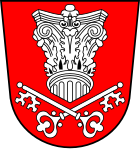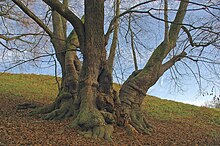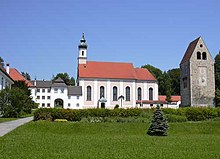Wessobrunn
| coat of arms | Germany map | |
|---|---|---|

|
Coordinates: 47 ° 53 ' N , 11 ° 2' E |
|
| Basic data | ||
| State : | Bavaria | |
| Administrative region : | Upper Bavaria | |
| County : | Weilheim-Schongau | |
| Height : | 702 m above sea level NHN | |
| Area : | 51.12 km 2 | |
| Residents: | 2269 (Dec. 31, 2019) | |
| Population density : | 44 inhabitants per km 2 | |
| Postal code : | 82405 | |
| Area code : | 08809 | |
| License plate : | WM, SOG | |
| Community key : | 09 1 90 158 | |
| LOCODE : | DE ZJJ | |
| Community structure: | 51 parts of the community | |
| Address of the municipal administration: |
Zöpfstrasse 1 82405 Wessobrunn |
|
| Website : | ||
| Mayor : | Georg Guggemos (creating together ) | |
| Location of the municipality of Wessobrunn in the Weilheim-Schongau district | ||
Wessobrunn is a municipality in the Upper Bavarian district of Weilheim-Schongau .
The place is known nationwide for the Wessobrunn Monastery and the Wessobrunn Prayer , which was written in Old High German around 814 and was owned by the Wessobrunn Monastery, as well as the Wessobrunn School , which includes the most important stucco workers of the South German Baroque .
geography
Wessobrunn lies at an altitude of 701 meters above sea level. d. M. southwest of the Ammersee , northwest of Weilheim and southeast of Landsberg am Lech . The municipality stretches from the Bayerdießen forest to the foot of the Hohen Peißenberg . Of the 5110 hectares of the municipality, 3035 hectares are used for agricultural purposes, 1786 hectares are forest and 104 hectares of water.
Districts
The municipality has 51 officially named parts of the municipality (the type of settlement is given in brackets ):
|
|
|
history
Wessobrunn Monastery
The nucleus of today's place is the Wessobrunn monastery.
Monastery village Gaispoint
Wessobrunn used to be called the monastery. The nearby village was called Gaispoint or Geispoint, mentioned in 1483 as Gayspewnd . In 1128 the first parish church was consecrated in Wessobrunn. Accordingly, Gaispoint must have existed since 1100 at the latest. Like Wessobrunn, the name Gaispoint was originally a field name. It is derived from Middle High German avarice for 'goat' and biunde for 'enclosure' and denotes a fenced pasture for goats. In 1853, the places Gaispoint and Haid received official permission to use the name Wessobrunn.
Incorporations
On May 1, 1978 the previously independent community of Forst and larger areas of the dissolved community of Haid were incorporated.
Population development
Between 1988 and 2018, the municipality grew from 1,764 to 2,247 by 483 inhabitants or by 27.4%.
| year | 1840 | 1871 | 1900 | 1925 | 1939 | 1950 | 1961 | 1970 | 1987 | 1991 | 1995 | 2000 | 2005 | 2010 | 2015 |
| Residents | 1358 | 1462 | 1519 | 1641 | 1526 | 2317 | 1715 | 1693 | 1761 | 1862 | 1968 | 1988 | 2065 | 2121 | 2191 |
politics
Municipal council
After the local elections, the Wessobrunn municipal council is composed as follows:
| Party / list | 2020 election | Election 2014 | 2008 election |
|---|---|---|---|
| Seats | Seats | Seats | |
| Create together | 6th | - | - |
| List Wessobrunn | - | 4th | 5 |
| The list for everyone | 5 | 4th | 4th |
| Free forest voters' association | 2 | 4th | 3 |
| Haid voter community | 1 | 2 | 2 |
| Total seats | 14th | 14th | 14th |
mayor
Mayor since May 2020 is Georg Guggemos from the voter group Joint-Gestalten. His predecessor from 2008 was Helmut Dinter (The List for All).
coat of arms
Blazon : "In red a silver Corinthian capital with a pointed stump of a column in a perspective view above a pair of diagonally crossed silver keys."
Sports
Ice hockey: In the district of Forst there has been an ice hockey club since 1981, the SC Forst (Nature Boyz). With the exception of two years natural ice Bayernliga to a year hockey Bezirksliga Bayern , they play since the start of the ice hockey division Bavaria . The SC's greatest success was in 2000 when they won the championship of the Bavarian State League South. The Nature Boyz play their home games in the Peißenberg ice rink .
Attractions


Wessobrunn is known nationwide for the Wessobrunn prayer , the oldest German language monument with Christian content, which was named after the place where it was found and which is now kept in the Bavarian State Library in Munich . It belongs to a Latin code that was probably made around 814 in the diocese of Augsburg (but not in Wessobrunn). The text was carved in a stone in the 19th century, which stands as a memorial on Lindenplatz in front of the monastery entrance.
The entire complex of the Wessobrunn Monastery of the 17th / 18th centuries Century can only be compared in Bavaria with the monasteries in Tegernsee and Ettal . About a third is still preserved, including three monastery wings. The corridor, staircase and Tassilosaal in the prince and prelate wing are world famous because of the splendid stucco by Johann Schmuzer from the Wessobrunn stucco school. The monastery used to have a theater hall, the wooden ceiling of which can be viewed in the nearby Gasthof zur Post .
Of the Romanesque monastery church of St. Peter, only the bell tower made of tuff stone (around 1260), which is called the gray duke or Roman tower , remains today . A memorial stele rises at the location of the former high altar. The church foundations were uncovered at the end of the 19th century by Johann Nepomuk Sepp, who discovered late Romanesque stone sculptures. Some parts of it are exhibited in the bell tower, most of them are in the Bavarian National Museum in Munich, together with the Wessobrunn mother of holy hope . It is one of the three oldest surviving Marian images of grace in Bavaria and dates from 1250. A copy of it is in the Mariengrotte, which was built in 2009 in the Wessobrunn monastery garden .
The parish church of St. Johannes Baptist was built in 1757 in the baroque style. In addition to stucco work by Thassilo Zöpf , frescoes by Johann Baptist Baader with scenes from the life of John the Baptist can be seen. The figures on the high altar come from Franz Xaver Schmädl and are counted among his best achievements. The left side altar is adorned with the miraculous image of Mary - Mother of Beautiful Love , which came to Wessobrunn around 1700. It is of no significance in terms of art history, but is revered by its own brotherhood, which around 1750 comprised around 600,000 members; today there are significantly fewer. The painter was the Benedictine Innocent Metz . In the church there is also an important Romanesque wooden crucifix from around 1250, which was venerated by the people in the 18th and 19th centuries as an image of sorrow .
Another remnant of the monastery complex is the well house from the 17th century with the water from the three Wessobrunn springs.
The famous Tassilolinde stands on the monastery wall . It is a natural monument and is said to be around 1000 years old. After the legend of the founding of the monastery, Duke Tassilo had his visionary dream under her.
A cross was erected on the Kreuzberg above Wessobrunn to commemorate the martyrs of the year 955, and later the Kreuzberg chapel in the same place. The old wooden structure was replaced by a stone structure in 1595 and modernized in 1771 with frescoes by Matthäus Günther and stucco work by Thassilo Zöpf. The chapel surrounds the Hunnenstein , a boulder on which the monks are said to have been executed.
Paterzell is known for its former limestone quarry , the Ulrichsquelle (ophthalmic spring) and above all for the largest continuous yew tree in Germany, the Paterzeller Eibenwald .
The Burgstall Greut is located on the Schlossberg north of Haid . There are no remains of the former castle, but it is documented from the 15th century. According to a local tradition, it is said to have been the castle of the legendary source finder Wesso.
An event that attracts numerous visitors to Forst every year is the Leonhardiritt , which leads horse and rider once through the village and three times around the village church, which is dedicated to St. Leonhard. The event is organized by the members of the Forster Leonhardiverein, founded in 1961.
See also: List of architectural monuments in Wessobrunn and List of ground monuments in Wessobrunn
Personalities
- Thiento von Wessobrunn († 955 in Wessobrunn), blessed abbot and martyr
- Diemut von Wessobrunn († March 30, 1130 in Wessobrunn), blessed Inclusive and illuminator of around 45 codices
- Walto von Wessobrunn († December 27, 1156/57 in Wessobrunn), blessed abbot
- Johann Schmuzer (1642–1701), plasterer and founder of the Wessobrunn school
- Franz Joseph Feuchtmayer (1660–1718), sculptor and plasterer
- Johann Jakob Vogel (1661–1727), plasterer
- Johann Michael Feuchtmayer the Elder (1666–1713), painter and engraver
- Joseph Schmuzer (1683–1752), Rococo builder
- Johann Baptist Zimmermann (1680–1758), painter and plasterer
- Dominikus Zimmermann (1685–1766), plasterer and master builder
- Franz Xaver Feuchtmayer the Elder (1698–1763), plasterer
- Anton Gigl (1700–1769), plasterer
- Johann Georg Üblhör (born March 23, 1703 in Wessobrunn; † April 27, 1763 in Maria Steinbach), plasterer and sculptor
- Johann Michael Feuchtmayer the Younger (1709–1772), sculptor and plasterer
- Johann Georg Gigl (1710–1765), plasterer
- Johann Kaspar Gigl (1737–1784), plasterer, sculptor, altar builder and bricklayer
- Luise Rinser (1911–2002), writer. Spent parts of her childhood in Wessobrunn and is buried there. The story The Glass Rings draws on childhood experiences in Wessobrunn.
panorama
literature
- Gabriele Dischinger and Eva Christina Vollmer: Schnell-Kunstführer No. 526: Wessobrunn. Former Benedictine monastery, parish church of St. Johann Baptist and Kreuzberg chapel . 16th edition. Schnell and Steiner publishing house, Regensburg 2003, ISBN 978-3-795-44312-2
- Luise Rinser : Place of my childhood: Wessobrunn . Owl publishing house, Freiburg i. Br. 1987, ISBN 978-3-89102-208-5
- Wessobrunn community (publisher): 1250 years of Wessobrunn. Festschrift . Fink Verlag, Lindenberg 2003, ISBN 978-3-89870-128-0
Web links
- Entry on the coat of arms of Wessobrunn in the database of the House of Bavarian History
- Wessobrunn: Official statistics of the LfStat (PDF; 1.24 MB)
- Homepage of the Wessobrunn Monastery
- Wessobrunn . In: Meyers Konversations-Lexikon . 4th edition. Volume 16, Verlag des Bibliographisches Institut, Leipzig / Vienna 1885–1892, p. 550.
- Parish of Wessobrunn with guided tours in Wessobrunn Monastery
Individual evidence
- ↑ "Data 2" sheet, Statistical Report A1200C 202041 Population of the municipalities, districts and administrative districts 1st quarter 2020 (population based on the 2011 census) ( help ).
- ↑ Wessobrunn municipality. Retrieved May 2, 2019 .
- ^ Community Wessobrunn in the local database of the Bavarian State Library Online . Bayerische Staatsbibliothek, accessed on September 4, 2019.
- ^ Federal Statistical Office (ed.): Historical municipality directory for the Federal Republic of Germany. Name, border and key number changes in municipalities, counties and administrative districts from May 27, 1970 to December 31, 1982 . W. Kohlhammer, Stuttgart / Mainz 1983, ISBN 3-17-003263-1 , p. 595 .
- ↑ Municipal statistics from Wessobrunn , accessed on November 5, 2010
- ↑ Local election 2020 Wessobrunn municipality council. In: wessobrunn.de. March 24, 2020, accessed May 6, 2020 .
- ^ Result of the 2014 local elections , accessed on March 18, 2014
- ↑ Weilheimer Tagblatt of March 18, 2014, local section p. 8
- ↑ Roland Halmel: Special farewell greeting for Wessobrunn Mayor Dinter. In: merkur.de. May 5, 2020, accessed May 6, 2020 .
- ↑ nature-boyz.de, Info SC Forst
- ↑ ref rodi-db.de, league membership SC Forst









